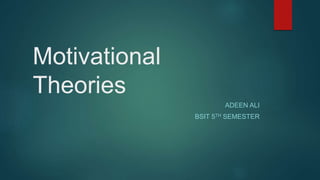
Motivational theories in IT project management
- 1. Motivational Theories ADEEN ALI BSIT 5TH SEMESTER
- 2. McGregor’s Theory X and Theory Y: Douglas McGregor (1906 –1964) was a famous management professor in the field of personal development and motivational theory. He is best known for his development of the Theory X and Theory Y, a leadership theory on two different leadership styles. He had a special interest in psychology and went to the Harvard University. First he earned his master (M.A.) in 1935 and in 1935 got his Ph.D. degree in social psychology.
- 3. Theory X: Theory X managers tend to take a pessimistic view of their people, and assume that they are naturally unmotivated and dislike work. As a result, they think that team members need to be prompted or punished constantly to make sure that they complete their task. This style of management assumes that workers: Dislike their work. Avoid responsibility and need constant direction. Have to be controlled, forced and threatened to deliver work. Need to be supervised at every step. Have no incentive to work or ambition, and therefore need to be enticed by rewards to achieve goals.
- 4. Theory Y: Theory Y managers have an optimistic, positive opinion of their people, and they use a decentralized, participative management style. This encourages a more collaborative, trust based relationship between managers and their team members. People have greater responsibility, and managers encourage them to develop their skills and suggest improvements. This style of management assumes that workers are: Happy to work on their own initiative. More involved in decision making. Self-motivated to complete their tasks. Seek and accept responsibility, and need little direction. View work as fulfilling and challenging. Solve problems creatively and imaginatively. Enjoy taking ownership of their work.
- 5. William Ouchy's Theory Z of Motivation: William Ouchy developed Theory Z after making a comparative study of Japanese and American management practices. Theory Z suggests that large complex organizations are human systems and their effectiveness depends on the quality of humanism used. A type Z organization has three major features—trust, subtlety and intimacy. Mutual trust between members of an organization reduces conflict and leads to team work. Subtlety requires sensitivity towards others and yields higher productivity. Intimacy implies concern, support and disciplined unselfishness.
- 6. The distinguishing features of Theory Z: Strong Bond between Organization and Employees Mutual Trust Employee Involvement Integrated Organization Coordination Informal Control System Human Resource Development
- 7. Influence: H. J. Thamhain and D. L. Wilemon investigated the approaches that project managers use to deal with workers and how those approaches relate to project success. They identified nine influence bases that are available to project manager. Influence is the ability to modify how a person develops, behaves, or thinks based on relationships and persuasion; often leading to respect
- 8. Influence: Authority: the legitimate hierarchical right to issue orders. Assignment: the project manager’s perceived ability to influence a worker’s later work assignments. Budget: the project manager’s perceived ability to authorize others’ use of discretionary funds. Promotion: the ability to improve a worker’s position. Money: the ability to increase a worker’s pay and benefits.
- 9. Contd.. Penalty: the project manager’s perceived ability to dispense or cause punishment. Work challenge: the ability to assign work that capitalizes on a worker’s enjoyment of doing a particular task, which taps an intrinsic motivational factor. Expertise: the project manager’s perceived special knowledge that others deem important. Friendship: the ability to establish friendly personal relationships between the project manager and others.
- 10. Power: Power is the potential ability to influence behavior to get people to do things they would not otherwise do. Coercive power involves using punishment, threats, or other negative approaches to get people to do things they do not want to do. This type of power is similar to Thamhain and Wilemon’s influence category called penalty. Legitimate power is getting people to do things based on a position of authority. This type of power is similar to the authority basis of influence. If top management gives project managers organizational authority, they can use legitimate power in several situations.
- 11. Contd.. Expert power involves using personal knowledge and expertise to get people to change their behavior. People who perceive that project managers are experts in certain situations will follow their suggestions. Reward power involves using incentives to induce people to do things. Rewards can include money, status, recognition, promotions, and special work assignments. Referent power is based on a person’s own charisma. People who have referent power are held in very high regard; others will do what they say based on that regard. People such as Martin Luther King, Jr., John F. Kennedy, and Bill Clinton had referent power
- 12. Covey and Improving Effectiveness: Project managers can apply Covey’s 7 habits to improve effectiveness on projects Be proactive Begin with the end in mind Put first things first Think win/win Seek first to understand, then to be understood Synergize Sharpen the saw
- 13. Emotional Intelligence: Good project managers are empathic listeners - they listen with the intent to understand Before you can communicate with others, you have to have rapport – a relation of harmony, conformity, accord, or affinity Mirroring is the matching of certain behaviors of the other person, a technique to help establish rapport IT professionals need to develop empathic listening and other people skills to improve relationships with users and other stakeholders
- 14. Leadership: Daniel Goleman, author of Emotional Intelligence, also wrote a book called Primal Leadership, which describes six different styles of leadership and situations where they are most appropriate. Visionary Coaching Affiliative Democratic Pacesetting Commanding
